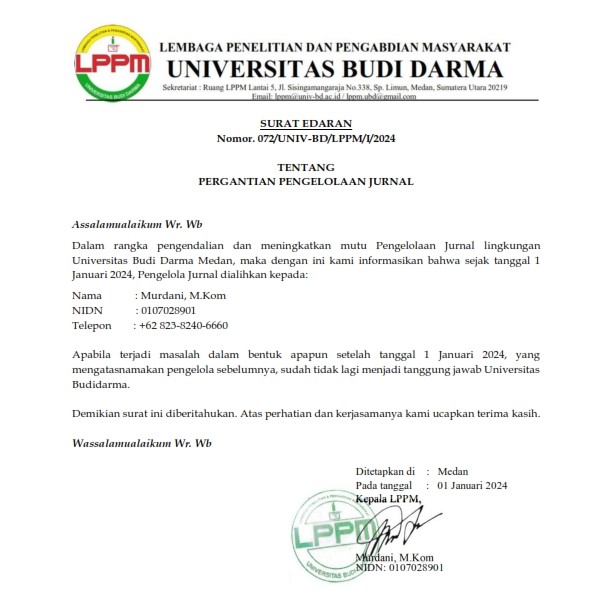Analisis Komparasi Algoritma Naïve Bayes dan K-Nearest Neighbor Untuk Memprediksi Kelulusan Mahasiswa Tepat Waktu
DOI:
https://doi.org/10.30865/mib.v5i2.2925Keywords:
Naïve Bayes, K-Nearest Neighbor, Student Graduation, Prediction, Algorithm ComparisonAbstract
Students are one of the important pillars in the life cycle of a university. In the process of developing, a university can be influenced by how many bachelor degree (S1) graduates from the university are. The number of graduations of a college sometimes has a low ratio when compared to the number of students admitted in the same school year. This low passing rate of students can be caused by several factors, such as the number of student activities that are participated in, economic factors, and several other unexpected factors. This makes a university must have a scheme or a formula that can predict whether the student can graduate on time. Normally, a bachelor (S1) student takes 8 semesters of education. But the existence of several factors that have been mentioned can make the time to take S1 education to be more, or even fail to graduate. This study will try to compare the results of the analysis of the two methods in the classification algorithm to predict student graduation. The algorithm used is the K-Nearest Neighbor and Naïve Bayes Algorithm. This study also aims to identify the best algorithm among the two classification algorithm choices. This research concluded that the Naïve Bayes algorithm has the same level of accuracy as the KNN algorithm in predicting the graduation of students in the Medical Education study program, which is 90%References
E. Yulianti and Y. A. Nurdin, “SISTEM PENDUKUNG KEPUTUSAN PENERIMAAN BANTUAN SISWA MISKIN (BSM) BERBASIS ONLINE DENGAN METODE KNN (K-NEAREST NEIGHBOR) (Studi kasus : SMPN 1 Koto XI Tarusan),†TEKNOIF, vol. 6, no. 1, pp. 12–17, 2018.
N. L. G. P. Suwirmayanti, “Penerapan Metode K-Nearest Neighbor Untuk Sistem Rekomendasi Pemilihan Mobil,†Techno, vol. 16, no. 2, pp. 120–131, 2017.
R. N. Devita, H. W. Herwanto, and A. Wibawa Prasetya, “PERBANDINGAN KINERJA METODE NAIVE BAYES DAN K-NEAREST NEIGHBOR UNTUK KLASIFIKASI ARTIKEL BERBAHASA INDONESIA,†JTIIK, vol. 5, no. 4, pp. 427–434, 2018.
R. Nuari, A. Apriliyani, Juwari, and Kusrini, “IMPLEMENTASI METODE K-NEAREST NEIGHBOR (KNN) UNTUK MEMPREDIKSI VARIETAS PADI YANG COCOK UNTUK LAHAN PERTANIAN,†INFORMA, vol. 4, no. 2, pp. 2–8, 2018.
M. Guntur, J. Santony, and Yuhandri, “Prediksi Harga Emas dengan Menggunakan Metode Naïve Bayes dalam Investasi untuk Meminimalisasi Resiko,†RESTI, vol. 2, no. 1, pp. 354–360, 2018.
C. Fadlan, S. Ningsih, and A. P. Windarto, “PENERAPAN METODE NAÃVE BAYES DALAM KLASIFIKASI KELAYAKAN KELUARGA PENERIMA BERAS RASTRA,†JUTIM, vol. 3, no. 1, pp. 1–8, 2018.
H. Annur, “KLASIFIKASI MASYARAKAT MISKIN MENGGUNAKAN METODE NAÃVE BAYES,†Ilk. J. Ilm., vol. 10, no. 2, pp. 160–165, 2018.
R. Ardianto, T. Rivanie, Y. Alkhalifi, F. S. Nugraha, and W. Gata, “SENTIMENT ANALYSIS ON E-SPORTS FOR EDUCATION CURRICULUM USING NAIVE BAYES AND SUPPORT VECTOR MACHINE,†J. Ilmu Komput. dan Inf., vol. 13, no. 2, 2020.
R. W. Pratiwi and Y. S. Nugroho, “Prediksi Rating Film Menggunakan Metode Naïve Bayes,†Tek. Elektro, vol. 8, no. 2, pp. 60–63, 2016.
Y. I. Kurniawan, “PERBANDINGAN ALGORITMA NAIVE BAYES DAN C.45 DALAM KLASIFIKASI DATA MINING,†JTIIK, vol. 5, no. 4, pp. 455–464, 2018.
V. Vangara and S. P. Vangara, “Opinion Mining Classification using Naive Bayes Algorithm,†IJITEE, vol. 9, no. 5, 2020.
D. Nofriansyah, K. Erwansyah, and M. Ramadhan, “Penerapan Data Mining dengan Algoritma Naive Bayes Clasifier untuk Mengetahui Minat Beli Pelanggan terhadap Kartu Internet XL (Studi Kasus di CV. Sumber Utama Telekomunikasi),†SAINTIKOM, vol. 15, no. 2, pp. 81–92, 2016.
E. Sutoyo and A. Almaarif, “Educational Data Mining untuk Prediksi Kelulusan Mahasiswa Menggunakan Algoritme Naïve Bayes Classifier,†J. RESTI, vol. 1, no. 10, pp. 95–101, 2021.
A. P. Giovani, Ardiansyah, T. Haryanti, L. Kurniawati, and W. Gata, “ANALISIS SENTIMEN APLIKASI RUANG GURU DI TWITTER MENGGUNAKAN ALGORITMA KLASIFIKASI,†J. TEKNOINFO, vol. 14, no. 2, pp. 116–124, 2020.
H. Saadatfar, S. Khosravi, J. H. Joloudari, A. Mosavi, and S. Shamshirband, “A New K-Nearest Neighbors Classifier for Big Data Based on E ffi cient Data Pruning,†Mathematics, vol. 8, no. 286, pp. 1–12, 2020.
L. Farokhah, “IMPLEMENTASI K-NEAREST NEIGHBOR UNTUK KLASIFIKASI BUNGA IMPLEMENTATION OF K-NEAREST NEIGHBOR FOR FLOWER CLASSIFICATION WITH EXTRACTION OF RGB COLOR FEATURES,†JTIIK, vol. 7, no. 6, pp. 1129–1136, 2020.
Muhathir, T. T. S. Sibarani, and Al-Khowarizmi, “Analysis K-Nearest Neighbors ( KNN ) in Identifying Tuberculosis Disease ( Tb ) By Utilizing Hog Feature Extraction,†AIoCSIT, vol. 1, no. 1, pp. 33–38, 2020.
Downloads
Published
Issue
Section
License

This work is licensed under a Creative Commons Attribution 4.0 International License
Authors who publish with this journal agree to the following terms:
- Authors retain copyright and grant the journal right of first publication with the work simultaneously licensed under Creative Commons Attribution 4.0 International License that allows others to share the work with an acknowledgment of the work's authorship and initial publication in this journal.
- Authors are able to enter into separate, additional contractual arrangements for the non-exclusive distribution of the journal's published version of the work (e.g., post it to an institutional repository or publish it in a book), with an acknowledgment of its initial publication in this journal.
- Authors are permitted and encouraged to post their work online (e.g., in institutional repositories or on their website) prior to and during the submission process, as it can lead to productive exchanges, as well as earlier and greater citation of published work (Refer to The Effect of Open Access).



